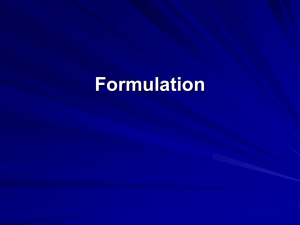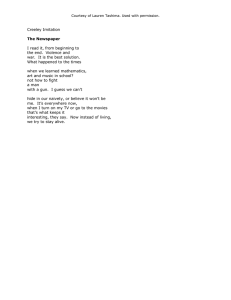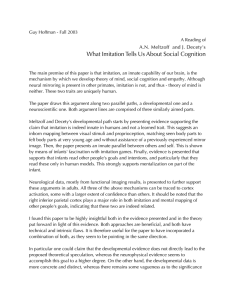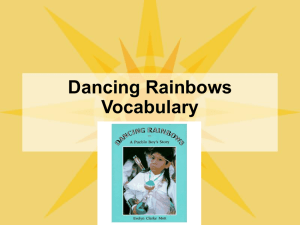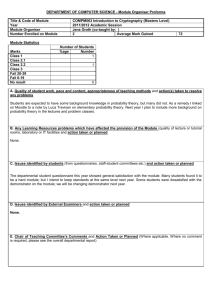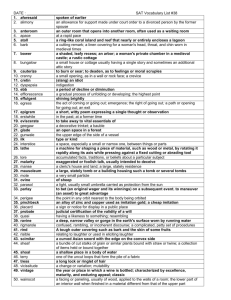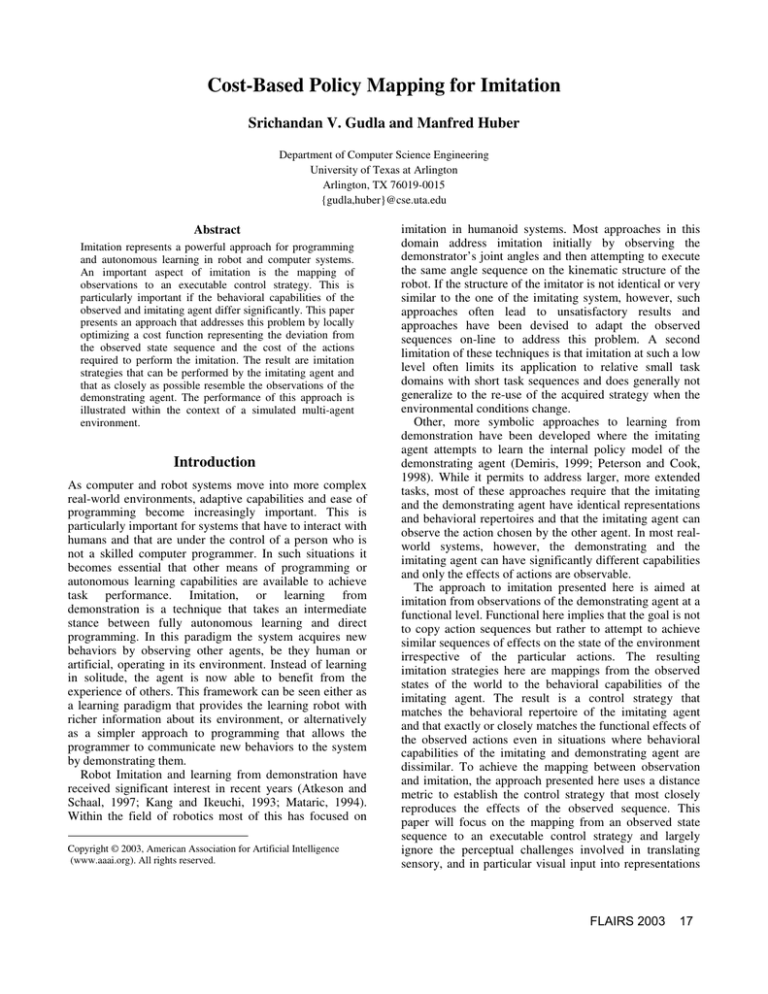
Cost-Based Policy Mapping for Imitation
Srichandan V. Gudla and Manfred Huber
Department of Computer Science Engineering
University of Texas at Arlington
Arlington, TX 76019-0015
{gudla,huber}@cse.uta.edu
Abstract
Imitation represents a powerful approach for programming
and autonomous learning in robot and computer systems.
An important aspect of imitation is the mapping of
observations to an executable control strategy. This is
particularly important if the behavioral capabilities of the
observed and imitating agent differ significantly. This paper
presents an approach that addresses this problem by locally
optimizing a cost function representing the deviation from
the observed state sequence and the cost of the actions
required to perform the imitation. The result are imitation
strategies that can be performed by the imitating agent and
that as closely as possible resemble the observations of the
demonstrating agent. The performance of this approach is
illustrated within the context of a simulated multi-agent
environment.
Introduction1
As computer and robot systems move into more complex
real-world environments, adaptive capabilities and ease of
programming become increasingly important. This is
particularly important for systems that have to interact with
humans and that are under the control of a person who is
not a skilled computer programmer. In such situations it
becomes essential that other means of programming or
autonomous learning capabilities are available to achieve
task performance. Imitation, or learning from
demonstration is a technique that takes an intermediate
stance between fully autonomous learning and direct
programming. In this paradigm the system acquires new
behaviors by observing other agents, be they human or
artificial, operating in its environment. Instead of learning
in solitude, the agent is now able to benefit from the
experience of others. This framework can be seen either as
a learning paradigm that provides the learning robot with
richer information about its environment, or alternatively
as a simpler approach to programming that allows the
programmer to communicate new behaviors to the system
by demonstrating them.
Robot Imitation and learning from demonstration have
received significant interest in recent years (Atkeson and
Schaal, 1997; Kang and Ikeuchi, 1993; Mataric, 1994).
Within the field of robotics most of this has focused on
Copyright © 2003, American Association for Artificial Intelligence
(www.aaai.org). All rights reserved.
imitation in humanoid systems. Most approaches in this
domain address imitation initially by observing the
demonstrator’s joint angles and then attempting to execute
the same angle sequence on the kinematic structure of the
robot. If the structure of the imitator is not identical or very
similar to the one of the imitating system, however, such
approaches often lead to unsatisfactory results and
approaches have been devised to adapt the observed
sequences on-line to address this problem. A second
limitation of these techniques is that imitation at such a low
level often limits its application to relative small task
domains with short task sequences and does generally not
generalize to the re-use of the acquired strategy when the
environmental conditions change.
Other, more symbolic approaches to learning from
demonstration have been developed where the imitating
agent attempts to learn the internal policy model of the
demonstrating agent (Demiris, 1999; Peterson and Cook,
1998). While it permits to address larger, more extended
tasks, most of these approaches require that the imitating
and the demonstrating agent have identical representations
and behavioral repertoires and that the imitating agent can
observe the action chosen by the other agent. In most realworld systems, however, the demonstrating and the
imitating agent can have significantly different capabilities
and only the effects of actions are observable.
The approach to imitation presented here is aimed at
imitation from observations of the demonstrating agent at a
functional level. Functional here implies that the goal is not
to copy action sequences but rather to attempt to achieve
similar sequences of effects on the state of the environment
irrespective of the particular actions. The resulting
imitation strategies here are mappings from the observed
states of the world to the behavioral capabilities of the
imitating agent. The result is a control strategy that
matches the behavioral repertoire of the imitating agent
and that exactly or closely matches the functional effects of
the observed actions even in situations where behavioral
capabilities of the imitating and demonstrating agent are
dissimilar. To achieve the mapping between observation
and imitation, the approach presented here uses a distance
metric to establish the control strategy that most closely
reproduces the effects of the observed sequence. This
paper will focus on the mapping from an observed state
sequence to an executable control strategy and largely
ignore the perceptual challenges involved in translating
sensory, and in particular visual input into representations
FLAIRS 2003
17
of the state of the environment. The techniques introduced
here will be illustrated using the WISE simulation
environment (Holder and Cook, 2001) which is based on
the Wumpus world computer game.
Imitation Using Cost-Based Policy Mapping
Imitation takes place when an agent learns a task from
observing the execution of the same task by a teacher or
demonstrator. In general, the demonstrator can here be
another artificial agent or ideally a human while the
imitator is a robot or an artificial computer agent. This
general definition implies that the behavioral capabilities
of the two agents involved here can be substantially
different and that the imitating might not be capable of
performing the precise action sequence of the
demonstrating agent. Moreover, it might not be capable of
fully performing all aspects of the task in the same fashion
due to missing capabilities. For example, if a mobile robot
with a simple front gripper is to imitate a human
demonstrator for a house cleaning task, it will generally not
be capable of performing all aspects of the demonstration
in the same fashion. It might, for example, not be capable
to reach on top of a book shelf to dust due to its limited
size. Similarly, it will not be able to perform other aspects
of the task in the same fashion as the human. For example,
to pick a magazine off the floor, the human will bend down
and reach forward. To achieve the same functional
outcome, the mobile robot will have to drive up to the
magazine and then close its gripper on it, thus executing an
action sequence that, at the behavior level, differs
substantially from the one observed. The approach
presented here addresses this challenge by means of
establishing a lowest cost approximation to the observed
sequence. The result is an agent that approximately repeats
the observed task.
Underlying the approach presented here is a view that
sees imitation as a three step process leading from
perceptual observations to the execution and storage of a
corresponding, executable control policy:
1. Mapping perceptual observations to a model of
the observed task execution
2. Mapping the observed model onto the internal
behavior model of the imitating agent
3. Execution of the resulting policy
The first step here involves translating the perceptual
input stream into a discrete representation of the sequence
of the observed events. The resulting model of the
observed task takes the form of a discrete Markov model
where states represent the observed state of the
demonstrator and the environment and transition occur
whenever a significant observable change in the state is
detected. Since actions are not directly observable, no
actions are associated with the transitions. Similarly,
aspects of the state that can not be directly observed or that
can not be extracted by the perceptual routines will also not
be represented in the model of the observed task.
18
FLAIRS 2003
The second step is concerned with mapping the
observed behavior model onto the internal model of the
imitating agent. The internal model is again represented as
a discrete Markov model where states represent states of
the environment and of the imitating agent. In contrast to
the observed model of the demonstrator, however, the
internal model is a complete representation of the
behavioral capabilities of the imitator. States occurring in
the model represent all possible states that can be achieved
actively by the agent using all options in its behavioral
repertoire. Transitions of the internal model correspond to
the effects of the execution of a particular action by the
agent. In general, this model can be learned by the agent by
exploring the range of actions at its disposal or can be preprogrammed by the designer using the available
knowledge about the operation of the agent. The goal of
the model mapping process is then to find the policy, i.e. a
mapping from states to actions in the internal model that
produces the state sequence that most closely matches the
sequence represented in the model of the observed task and
thus most closely reproduces the functional outcomes of
the observed task.
In the third step, the imitating agent executes the policy
identified in the second step, thus imitating the agent. If the
internal model is an accurate representation of the actual
behavioral capabilities of the imitating agent the execution
of the policy should be straightforward.
This paper focuses on the second step and thus assumes
that the perceptual capabilities to generate the model of the
observations are available and that the model of the
observed task is already constructed. The main task
addressed here is the mapping from the observed model to
the internal model. In general, this will require identifying
correspondences between states of the observed model and
states in the internal model and searching for a state and
transition sequence that matches the one observed. For the
purpose of this paper it is assumed that the states in the
observed and in the internal model are built on the same
state representation and thus that there is a one-to-one
correspondence between observed and internal states.
However, since the behavioral capabilities of the
demonstrator and the imitating agent are generally not
identical, the mapping process might not result in the exact
same state sequence for the imitator, requiring the
identification of the closest matching sequence which
might include additional transitions or might not include
certain observed states because they can not be achieved
by the imitator or prevent it from achieving the remainder
of the task.
To identify the best matching policy, the approach
presented here searches for the best match using a cost
function defined on the state and action space of the
internal model. Figure 1 illustrates the basic model
mapping parameters used. Here, the observed model states
(dark states) are mapped to internal states (light states)
using a cost criterion consisting of a distance metric
between the states and the cost of the actions selected in
the internal model.
D2
D1
A1
D3
A3
A2
Ignored
Di
D5
D4
D6
A4
A5
Demonstrator Model
State
Transitions
Imitator Model State
Mapping
Cost of distance
Ai
Cost of action
Figure 1: Cost-based model mapping
Cost-Based Model Mapping
To map the state and transition sequence of the observed
model to the internal model of the agent, the approach
taken here has to address two main parts:
1. Mapping the start state of the observed model to a
corresponding start state in the imitator’s.
2. Mapping each transition in the observed model
onto transitions in the imitator’s internal model
such as to produce the closest matching state
sequence.
The first part here involves determining the internal state
that most closely matches the start state of the
demonstrating agent and potentially finding a policy that
moves the imitator to this state. The second part then
corresponds to matching the observed transition sequence
to an executable transition sequence for the imitator. Both
of these mapping steps are achieved here by optimizing a
cost function C. The cost function used here consists of
two components representing the cost of the actions
selected to achieve the mapped transitions, Ca , and a cost,
Cs , computed based on a distance metric between the
observed and mapped states:
C = Ca + Cs
For the example in Figure 1 these cost factors can be
computed as:
Ca = A1 + A2 + A3 + A4 + A5
Cs = D1 + D2 + D3 + D4 + D5 + D6
Where Ai is the cost of the action associated with the ith
transition and Dj is the distance metric between the jth state
mapping between the observed sequence and the matched
internal state sequence. It is important to note here that the
state and transition mapping between observed and internal
model is generally not one-to-one and that therefore
multiple distances can be associated with each state in
these sequences. These cost factors can be defined in
different ways by the user or an autonomous learning
component, resulting in the potential for different types of
imitation behavior. For example, by giving more weight to
one feature of the internal state representation, the
importance of exactly matching the parts of task related to
this feature will be emphasized while features with lower
weights might be ignored if their achievement introduces
too high a cost. In this way, the choice of cost function can
directly influence the resulting imitation policy, thus
providing additional flexibility to this approach.
A second choice in the construction of the matching
state sequence in the internal model is the one between
establishing lowest cost matches locally across a short part
of the model or doing so globally for the complete model.
While establishing a minimum cost match globally would
result in the best match according to the cost function used,
the cost of such a procedure is very high. Moreover,
establishing such a global match can only be accomplished
if the entire demonstration is observed before the imitation
strategy is formed and executed. Using a local matching
procedure, on the other hand, can permit an imitating agent
to start executing the first steps of the imitation policy
before the demonstrator has finished the complete task.
The approach presented here forms a local solution by
incrementally searching for state and transition matches in
the observed sequence. This local solution could be used
subsequently as a starting point for a global optimization
procedure to improve the policy for future use.
In the course of locally mapping the sequence of
observed states to the internal model it is possible that
states can either be matched exactly or that they have to be
approximated because the behavioral capabilities of the
imitating agent are not sufficient to achieve the exact
outcome produced by the demonstrator.
Exact State Mapping
If the exact outcome state of a transition in the model of
the observed task can be achieved by the imitating agent,
the local mapping approach taken here still searches for the
lowest cost policy to achieve this state. This however
might require different actions as the one used by the
demonstrator and a transition in the observed model might
thus be mapped to a transition sequence of variable length
in the imitator’s internal model. In addition, multiple action
sequences can potentially achieve the same outcome,
requiring to select one of them. Here, the cost function is
used as the selection criterion. Since the start and end
states of each observed transition exactly match the ones
selected in the internal model, the match is based largely
on the cost of the selected actions. To find the lowest cost
action sequence that accomplishes the desired overall
transition, a search algorithm is used here. During search,
the cost function serves as a heuristic and pruning criterion.
Figure 2 shows an example result of this search process.
This figure shows the alternatives encountered during
the search process and the associated action costs. The
policy chosen by the imitating agent is the bottom one
which has the lowest cost.
FLAIRS 2003
19
7
3
1
1
1
1
1
A3
Figure 2: Search for optimal cost action sequence to
perform an observed state transition
A side effect of using the cost function for model
mapping is that demonstrator actions that do not change
the observable state will be ignored as shown in Figure 3.
Ignored
Figure 3: Removal of self-loops during mapping
This search process sequentially maps each state
transition in the observed model to a sequence of
transitions in the internal model of the imitating agent if
they can be achieved. However, if the behavioral
capabilities of the imitator are substantially different from
the ones of the demonstrating agent, the outcome of a
transition might not be achievable and the imitator has to
find a policy that most closely approximates the outcome.
Approximate State Mapping
If the end state of an observed transition is not reachable,
the algorithm incrementally increases its search horizon to
find action sequences that skip states in the observed
sequence. It does so in the forward as well as the backward
direction (i.e. by backtracking along the already mapped
policy segments) to find the lowest cost approximation.
Figure 4 shows an example where neither the first nor
the second transitions are achievable by the imitating
agent. In this figure, two possible transition strategies that
can replace the initial observed transitions are indicated.
Each of these skips one of the states in the observed
sequence. If no action sequence for these cases can be
found, the search horizon is extended further to include
hypothetical observation sequences where one more state
of the observed sequence is ignored. To limit the time
spent in this process, the algorithm used here limits the
maximum search horizon and if no action sequence is
found that achieves the later state of the observed model
exactly, reverts to the action sequence that throughout the
search process led to the state most closely matching a
state in the observed sequence.
20
FLAIRS 2003
A2
A1
3
A4
Figure 4: Search for lowest cost action sequence for
observation models with unachievable transitions
Experiments
To illustrate the operation and results of the approach
presented here, a number of experiments have been
performed using a simulated agent environment related to
the Wumpus World computer game. In this environment,
the agent moves through a grid world to collect gold pieces
(G). At the same time it has to avoid pits and wumpi (W),
fierce creatures that can kill the agent. Also the agent can
kill the wumpi in some particular conditions. The actions
available to the imitating agent are Forward (GF), Turn left
(L), Turn right (R), Shoot (S), and Grab (G). The Shoot
operation is used to shoot a wumpi which will be killed if
it is in the way the agent faces and Grab operation is used
to collect the gold pieces. In these experiments, both
demonstrator and imitator agent have been implemented.
The imitating agent observes the state of the demonstrator
and uses this to derive an imitation strategy.
Here each observed state from the file contains the
information of the observable features of the demonstrator
including the change in the world state. Including only the
change in state decreases the amount of memory used as
compared to storing the full instance of the world state.
The features of the agent used here are the current x and y
coordinates, the orientation, and if the agent carries a piece
of gold. The features of the world included in the state are
the presence and location of any wumpi or pieces of gold
in the world. Since the wumpi can potentially kill an agent,
a high negative reward is associated with the agent
encountering a wumpus in order to avoid imitation in
situations where the demonstrator is not affected by the
wumpus. The weights for this reward can be changed by
the user to make the imitator act differently.
For test case 1, the observed model starts from an initial
position, shoot a wumpus on its way to a position where
gold lies. Then it grabs the gold and returns to the start
position to exit using the action Climb (C). However, the
imitator agent, who observes the same discrete number of
states and transitions, does not repeat the task in the same
way since it is not capable of shooting. Instead it tries to
approximate the task as shown in the Figure 5.
This figure shows that the imitator model initially
performs in the same way as the demonstrator. However,
instead of shooting the wumpus as the demonstrator, it
changes its orientation by turning left, moves up through
R
GF
GF
therefore passes by the location without executing the grab
action and returns to its original position without the gold.
R
GF
GF
W
GF
GF
Conclusions and Future Work
GF
L
L
GF
Start
G
G,R,R
Goal
W
C
GF
L
GF
GF
W
GF
GF
L
GF
R
GF
GF
R
Figure 5: Test Case 1
the Forward action until it can avoid the three wumpi, and
makes its way towards the nearest approximately matched
state of the observed model. Then it grabs the gold and on
its way back again encounters the risk of being killed by
the wumpi. Hence it again acts differently from the
demonstrator and ultimately reaches a state close to the
observed state and exits in the same way as demonstrator.
GF
S
GF
Start
GF
Acknowledgements
GF
W
Goal
This work was supported in part by NSF ITR-0121297
G
R,R
C
GF
GF
GF
This paper presented an approach to imitation that
constructs an imitation strategy by mapping an observed
model into the internal model of its behavioral capabilities.
This mapping uses a cost function, permitting it to be
applied in situations where the behavioral capabilities of
the demonstrating and imitating agent differ. The
experiments presented show that the imitator agent is
capable of imitating the demonstrator even under these
circumstances by addressing the same task differently
using its own action set. In this process it sometimes
deviates from the observed state sequence, finding the
closest state match that is achievable. This permits this
approach to be used even if the demonstrator and imitator
are different agent types.
To extend to real robot imitation, a number of additional
challenges have to be addressed. In such systems,
observations and internal states of the imitating agent can
differ significantly. This requires the addition of techniques
that permit to relate observed and internal states.
Furthermore, the strategy derived here represents a local
solution. However, if a task is to be performed repeatedly
by the imitator, it might be advantageous to attempt to
further optimize the derived strategy in order to more
closely approximate globally optimal task imitation.
GF
Figure 6: Test Case 2
For test case 2, as shown in the Figure 6, the observed
model starts from the start position, goes towards the gold
by shooting a wumpus in its path and grabs the gold. On its
way back to the start position it drops the gold and exits
without any gold. The imitator agent here has the
capability of shooting but not the capability of dropping
the gold. Hence it first shoots the wumpus in its way. Then
it plans to grab the gold but once arriving at the drop state
sees that it cannot drop the gold. It therefore starts
searching for approximate solutions by analyzing future
and past states for valid imitation strategies. In the course
of this it determines that the lowest cost approximate
imitation strategy does not include grabbing the gold. It
References
Atkeson, C.; and Schaal, S. 1997. Robot Learning From
Demonstration. In Proceedings of the Fourteenth
International Conference on Machine Learning, 12–20,
San Francisco, CA.
Demiris, J. 1999. Active and passive routes to imitation. In
Proceedings of the AISB’99 Symposium on Imitation in
Animals and Artifacts, Edinburg, Scotland.
Peterson, G.; and Cook, D.J. 1998. DFA learning of
opponent strategies. In Proceedings of the Florida AI
Research Symposium, 367–371.
Holder, L.; and Cook, D. 2001. An Integrated Tool for
Enhancement of Artificial Intelligence Curriculum.
Journal of Computing in Higher Education 12(2).
Kang, S.; and Ikeuchi, K. 1993. Toward automatic robot
instruction from perception: Recognizing a grasp from
observation. IEEE Journal Robotics Automat., 9(4).
Mataric, M. 1994. Learning motor skills by imitation. In
Proceedings, AAAI Spring Symposium Toward Physical
Interaction and Manipulation, Stanford University.
FLAIRS 2003
21


